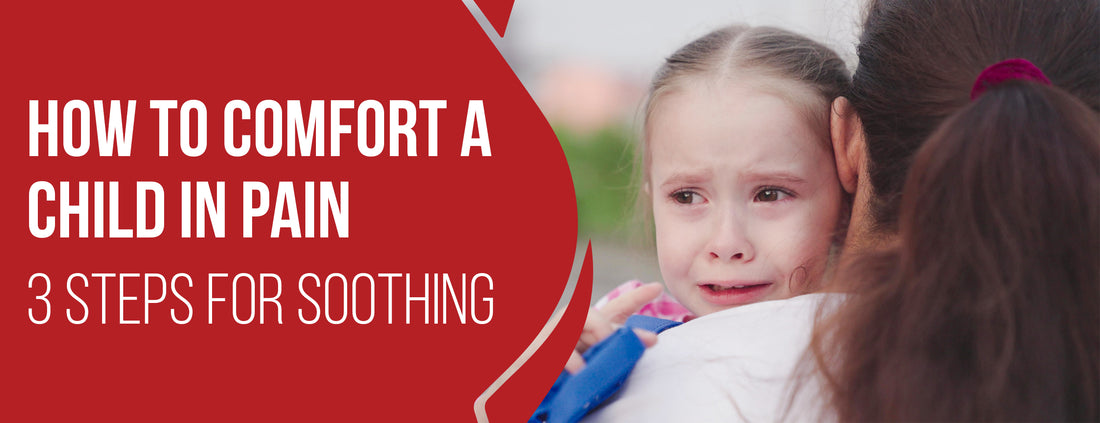Encourage your child to express feelings and ask questions about pain and illness. Let them know it's okay to cry and be upset. Validate their emotions and provide coping strategies. Listen to their concerns and model ways to cope with pain and stress.
It's natural to want to do everything in your power to help them feel better and alleviate their discomfort. Navigating the world of pain management for children can be overwhelming, especially if your child is non-verbal or has a chronic condition.
In this step-by-step guide, we'll walk you through comforting a child in pain. From recognizing and easing the pain to managing it at home, we'll cover everything you need to know to help your child during this difficult time.
How to Comfort A Child in Pain: 3 Steps

It can be heart-wrenching to see your child in pain. Whether it's a minor headache or a more severe injury, knowing how to identify and manage your child's pain can provide you comfort and peace of mind. That's why we've created a comprehensive guide on the steps you can take to recognize, ease, and manage pain in children.
Step 1: Recognize Pain
Signs and symptoms of pain in children
It's essential to recognize that children can experience pain differently than adults and may be unable to verbalize their discomfort. You can look for these common signs and symptoms of distress:
- Crying, screaming, or moaning.
- Clenched fists or tensing of the body.
- Changes in appetite or sleep patterns.
- Irritability or mood changes.
- Avoiding physical movements or touch.
- Increased heart rate or breathing.
Importance of communication
If your child is old enough to communicate, encourage them to express discomfort. Ask them to describe their pain using words like "sharp," "throbbing," or "aching." You can also use a pain scale to help your child rate their discomfort on a scale from 0-10.
When to seek medical attention
If you suspect your child's pain is severe or is accompanied by other symptoms, such as a high fever, vomiting, or loss of consciousness, seek medical attention immediately. Don't hesitate to call your doctor or take your child to the emergency room if you have any concerns.

Step 2: Ease the Pain
Various pain relief options
Several options for relieving your child's pain include medications, natural remedies, and distractions.
- Medications: Over-the-counter pain relievers such as acetaminophen or ibuprofen can alleviate mild to moderate pain. However, always consult with your doctor before giving your child any medication.
- Natural remedies: Some natural remedies that may help soothe your child's pain include applying a warm compress, massage, aromatherapy, or herbal remedies like ginger or chamomile.
- Distractions: Distracting your child's attention with activities like reading, singing, or coloring can help reduce their focus on the pain.
Discussing and understanding potential side effects
Discussing the potential side effects of any medication prescribed to your child with your doctor is essential. Some medicines may cause drowsiness or other adverse reactions that could harm your child.
Step 3: Manage Pain at Home
Creating a comfortable environment

Creating a calm and comfortable environment can help your child feel better in pain. Ensure the room is quiet and dark, and offer soft blankets and pillows to make them feel more comfortable.
Monitoring and assessing pain levels
Regularly assess your child's pain level and adjust their treatment plan. Keep a pain journal to help you track any patterns or changes in their pain.
Communicating with your healthcare provider and seeking additional help if necessary
Always communicate with your healthcare provider if your child's pain persists or worsens. They may recommend additional treatments such as physical therapy or specialist referrals to help manage your child's pain.
A Child's Comfort in Pain: 3 Coping Strategies
Seeing a child in pain can be distressing for a concerned parent or caregiver. Whether it's caused by an illness, injury, or medical procedure, knowing how to help them manage their discomfort is essential. Here are some tips:
Child Pain Measurement
Pain is subjective and difficult to measure accurately, especially in children. Healthcare professionals use various pain scales to assess pain intensity in children. These scales typically involve the child pointing to a face that best reflects their level of discomfort. Some commonly used pain scales include:
- Wong-Baker FACES Pain Rating Scale.
- Visual Analog Scale (VAS).
- Numeric Rating Scale (NRS).
It's important to note that pain scales are not always reliable and should be used in conjunction with other assessment methods, such as observation and talking to the child.

Pain Management for Children
When a child is in pain, they need emotional support and comfort just as much as medical treatment. Here are some ways to help your child cope with pain:
- Open communication: Encourage your child to express their feelings about pain. Listen to them without judgment and validate their emotions. This will help them feel more in control and less alone.
- Emotional support: Offer physical comfort, such as hugs or holding their hand. Reassure them that they are not to blame for their pain and that they will get better.
- Positivity and encouragement: Help your child maintain a positive attitude by focusing on things that make them happy, such as reading their favorite book or watching a movie. Encourage them to stay engaged in their hobbies and interests, and praise them for their bravery and resilience.
Pain Coping Strategies for Children
In addition to emotional support, several coping strategies can help a child manage their pain:
- Relaxation techniques: Deep breathing, meditation, and progressive muscle relaxation can help your child relax their body and reduce their pain. Several apps designed for children provide guided meditation and relaxation exercises.
- Positive distractions: Engaging in enjoyable and distracting activities, such as playing a game or listening to music, can help your child take their mind off their pain.
- Mental visualization: Encourage your child to visualize themselves in a calm, peaceful place like a beach or forest. This can help them feel more relaxed and reduce their pain.
Comfort a Child in Pain: During Injections

When helping your child cope with pain during injections, you can add several non-pharmacological methods to make the experience less distressing. Here are some effective strategies to consider:
- Comfort Position: Allow your child to choose a comfortable position for the injection. Holding their hand or sitting in their lap can provide security and comfort.
- Topical Anesthetics: Consult with the healthcare provider about using topical anesthetics or numbing creams before the injection. These can help reduce the sensation of pain.
- Positive Reinforcement: Praise and reward your child for their bravery and cooperation. Positive reinforcement can boost their confidence and make future injections easier.
- Post-Injection Rewards: Plan a particular treatment or activity after the injection. This gives your child something to look forward to and helps create a positive association with the experience.
Conclusion
Managing a child's pain can be challenging, but with the right strategies and support, it's possible to help them feel more comfortable and cope with their discomfort. By combining physical and psychological processes, parents and caregivers can provide a comprehensive approach to pain management that addresses all their child's needs.
All children are different, and what works for one may not work for the other. However, by staying in close communication with healthcare providers and working together as a team, you can provide the best possible care for your child and support them through any pain they may encounter.










![The 7 Factors That Determine Whether You Can Get Lip Injections With Breastmilk [7 Safety Tips]](http://drnumb.com/cdn/shop/articles/Can_You_Get_Lip_Injections_While_Breastfeeding__6_Factors_7_Safety_Tips.jpg?v=1711186573)



